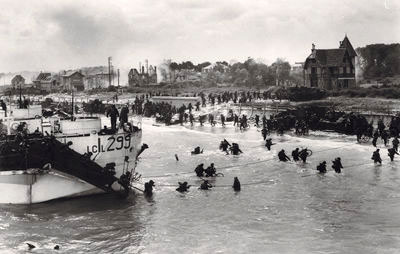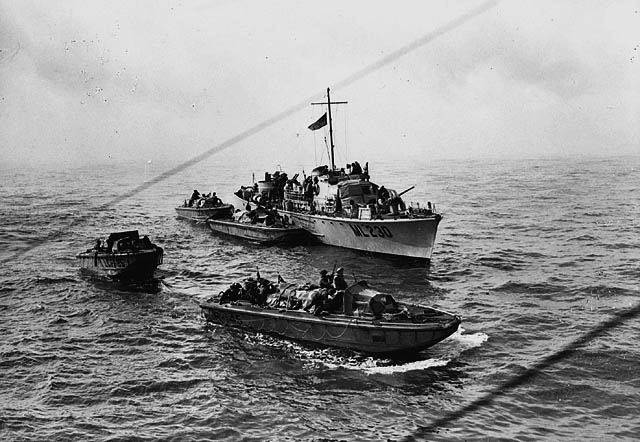The Battle of Normandy was one of the most important operations of the Second World War. It began the campaign to free Western Europe from Nazi occupation. Canadians played a key role in the Allied invasion of Normandy (called Operation Overlord). The campaign began on D-Day (6 June 1944) and ended with the battle of the Falaise Pocket (7–21 August 1944). Thousands of Canadians fought on D-Day and in the Normandy campaign and over 5,000 were killed. (This article is a plain-language summary. If you are interested in reading about this topic in more depth, please see our full-length entry, D-Day and the Battle of Normandy.)

Background
Canada had been at war with Germany since 1939. By 1944, the Allies were on the attack. They were winning the Battle of the Atlantic and advancing through Italy. In the east, the Soviets were pushing the Germans back. Soviet leader Joseph Stalin had been asking the British and Americans to invade France for a long time. An invasion in the west would take pressure off Soviet forces. The Allies finally agreed to an invasion, code-named Operation Overlord. It would be launched from Britain across the English Channel in 1944.
But the French side of the English Channel was well-defended. The Germans had built miles of concrete bunkers and machine gun nests along the coast. They also placed barbed wire, mines and other obstacles on the beaches. The Allies worried they would lose a lot of men, like they did during the Dieppe Raid of 1942. (More than 3,300 Canadians were killed at Dieppe.) But the Allies needed a French harbour to supply their armies during the campaign.
Deception and Planning
The Germans knew an invasion was coming, but they didn’t know where or when it would happen. They thought it might happen in the Pas de Calais, which was the shortest distance from England and the quickest route to Germany.
But the Allies decided to invade Normandy, further to the west. They planned the largest seaborne invasion in history. More than 156,000 soldiers would land on the beaches of Normandy or parachute behind German lines. All three services (army, navy, air force) would be involved.
To fool the Germans, the Allies pretended the invasion would happen in the Pas de Calais. They sent fake radio messages. They also built a dummy army of rubber, wooden and papier mâché tanks, trucks and other equipment in southeast England. But the real invasion force was in southwest England. Its location was kept secret. Soldiers studied maps, photos and 3D models of the invasion beaches so that they would be prepared.
D-Day
The invasion was supposed to happen on 5 June 1944, but it was postponed because of bad weather. In the early morning of 6 June, waves of planes and gliders began dropping paratroopers into the Normandy countryside. In the English Channel, more than 6,900 ships (including 80 Canadian vessels) sailed towards the French coast. After Allied ships and planes bombarded the German defences, the first waves of landing craft headed for the beaches. Allied soldiers faced heavy fire from German defenders but secured the Normandy beachhead by the end of the day. This allowed more troops, tanks, artillery and supplies to come ashore.
Nearly 150,000 Allied troops landed or parachuted into the area on D-Day, including 14,000 Canadians at Juno Beach. In total, more than 10,000 Allies were killed, wounded or captured on D-Day; this included 1,096 Canadians (381 killed in action).
Normandy Campaign
It took a summer of hard fighting to push through Normandy. While the Americans attacked the port city of Cherbourg, the British and Canadians tried to capture the city of Caen. By 9 July 1944, both the Carpiquet airport and much of Caen had been captured. The Canadians then fought battles at Vaucelles, Bourguébus Ridge and Verrières Ridge.
By early August, the Allies had launched a huge pincer movement to encircle the German army in Normandy. Eventually, they forced the Germans into a “pocket” near the town of Falaise. On 21 August 1944, the Allies captured about 40–50,000 German soldiers.
Aftermath
More than two million Allied soldiers landed in France during the Normandy campaign. The Allies had 209,000 casualties (killed, wounded, captured); this included about 18,700 Canadians. Over 5,000 Canadians were killed. More than 300,000 Germans were either killed, wounded or captured in the Normandy campaign. Between 13,000 and 20,000 French civilians died. The Normandy campaign was a military success for the Allies. But they faced a hard winter of fighting before they finally defeated the German army in the west.


 Share on Facebook
Share on Facebook Share on X
Share on X Share by Email
Share by Email Share on Google Classroom
Share on Google Classroom










